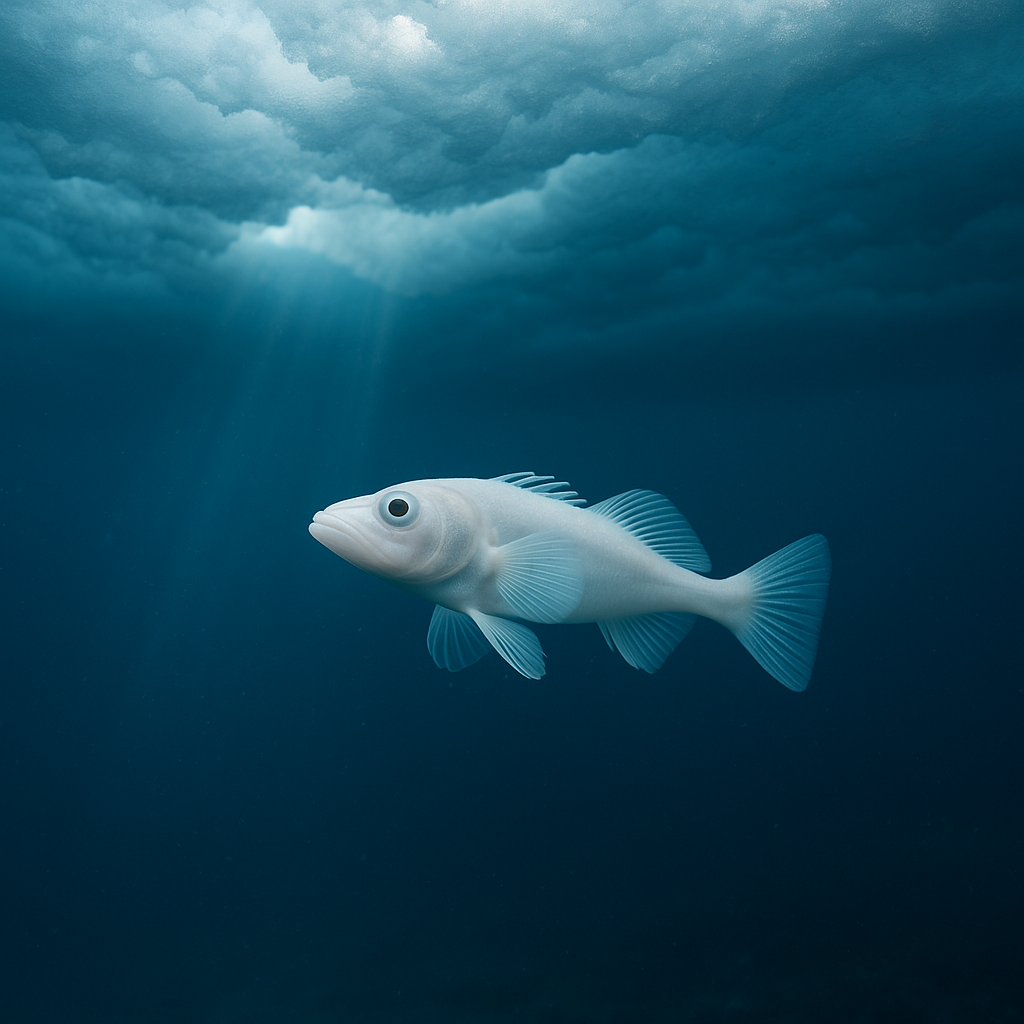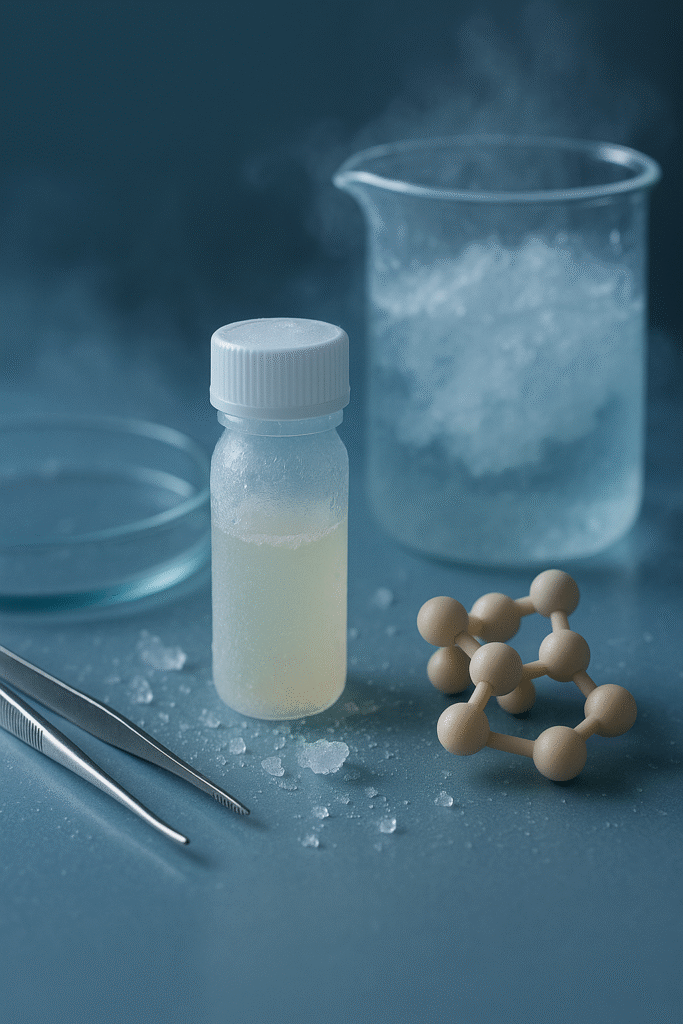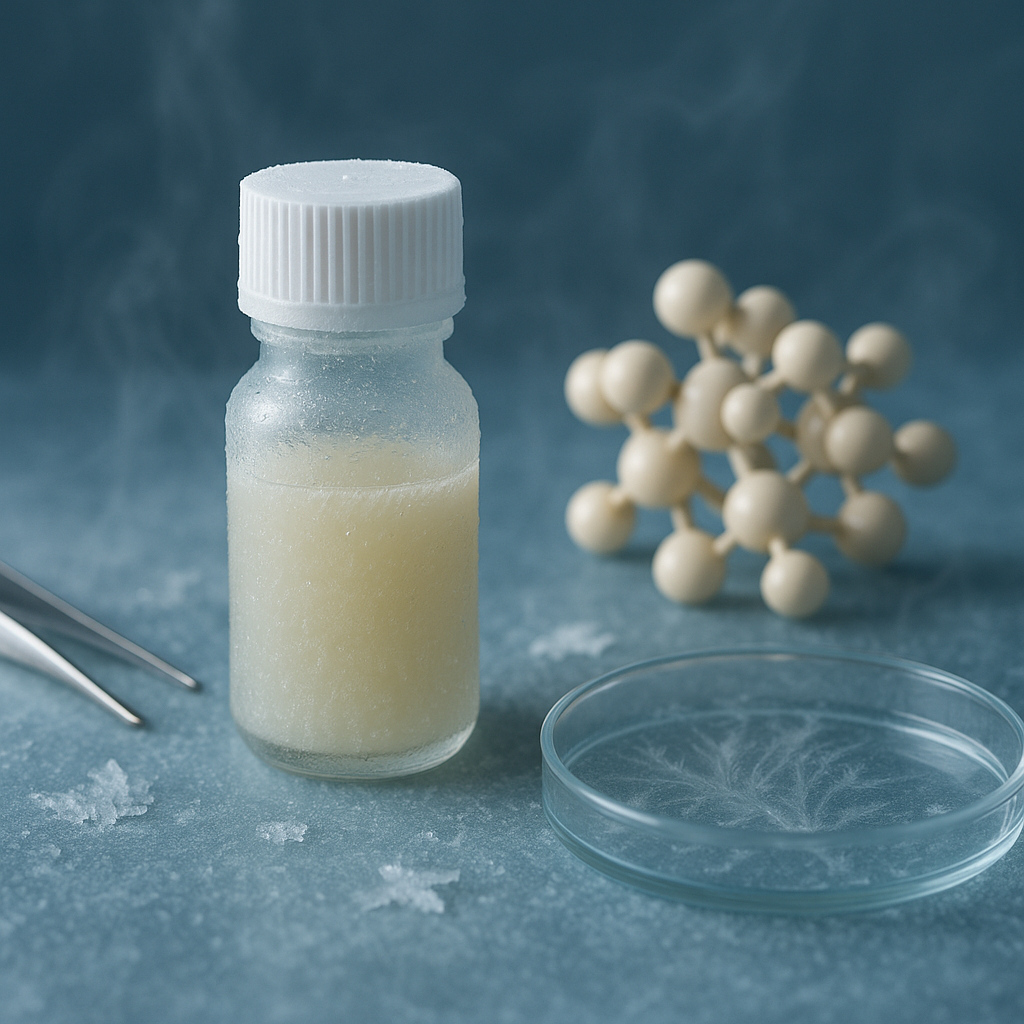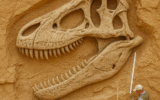Prologue: a pulse moving through ice
The Southern Ocean is a theater of contradictions—sunlight that lasts months, nights that swallow seasons, sea that freezes and loosens its grip like a sleeping giant. Beneath pack ice and berg-shadow, a fish glides with a heart too large for its body and blood so clear you can read a horizon through it. This is the Antarctic icefish, a member of the notothenioid radiation, the only vertebrate lineage on Earth that lives without hemoglobin. In a world that should stop the pulse of life, the icefish has found a way to let the ocean do some of the breathing for it. It is a story about physics made into flesh—about how cold remakes bodies, and how warming seas could unmake them again.

1) Identity: who the icefish are
“Antarctic icefish” refers to a family within the notothenioids commonly called the white-blooded or crocodile icefish. Dozens of species share this extreme physiology, inhabiting the frigid shelf waters and slopes around Antarctica and sub-Antarctic islands. Their silhouettes are pale, almost alabaster; their fins look lightly penciled onto glass. To hold one is to hold a paradox: a vertebrate that has abandoned the red pigment that defines vertebrate blood.
Key traits, simplified:
- Blood without hemoglobin: Most species possess no red blood cells; the plasma itself carries oxygen.
- Often no myoglobin in heart/skeletal muscle: Some species have lost this oxygen-binding pigment in muscle, too, forcing compensatory changes in circulation.
- Cold specialization: True children of the freezing point—their proteins, membranes, and enzymes are tuned to temperatures near −1.8 °C.
- Antifreeze glycoproteins: Like many notothenioids, they manufacture antifreeze molecules that keep ice crystals from growing inside their fluids.
- Slow life history: Growth is slow, maturity late, lifespans long, reproduction conservative—typical of organisms living where metabolism runs on the edge of a whisper.
The icefish are not a curiosity; they are a complete alternative design for life in water that is almost ice.
2) The hemoglobin trade-off: why “clear blood” can work
At first glance, the absence of hemoglobin appears suicidal. Hemoglobin transports oxygen efficiently; without it, the carrying capacity of blood plummets. The icefish solution is ecological and mechanical:
- Colder water holds more oxygen. The Southern Ocean’s frigid water is oxygen-rich; diffusion gradients are gentle yet reliable.
- Low viscosity, fast flow. Blood without cells is thin. Icefish pump more volume per beat with less resistance, moving oxygen quickly even if each milliliter carries little.
- Enlarged hearts and high cardiac output. Many icefish have oversized hearts with thin walls, designed to push big volumes of plasma slowly and steadily.
- Dense vascular networks and large gills. Surface area substitutes for pigment; oxygen exchange happens across generous interfaces.
- Scaleless or reduced-scale skin with cutaneous respiration. Oxygen can pass not only at gills but also across the skin, adding a quiet, constant trickle of supply.
In other words, the icefish turned circulation into a volume game. Rather than dye the blood red, they move more of it, more often, through pipes widened by evolution.
3) Antifreeze glycoproteins: the chemistry that forbids winter
When seawater hovers just below zero, the physics of freezing becomes the enemy. The notothenioids solved this with antifreeze glycoproteins (AFGPs)—small molecules that bind to microscopic ice crystals and prevent them from growing. AFGPs don’t “melt” ice; they reshape the energy landscape so that crystals cannot extend. The result is a thermal hysteresis—a tiny gap between the freezing point and the melting point that keeps fluids fluid.
This chemical ingenuity spreads risk. Even if ice nuclei slip into the body through gills or skin, they can’t recruit enough water molecules to become a lethal blade. In the long dark of polar winter, the antifreeze is both shield and permission slip: permission for life to operate in a temperature regime that would lock most vertebrates into silence.
4) Cold changes everything: membranes, enzymes, and motion
Life does not simply “slow down” in the cold; it re-tunes.
- Membrane fluidity: Lipid bilayers become stiffer in the cold. Icefish adjust the proportion of unsaturated fatty acids in cell membranes, keeping them supple so ion channels can open and close on cue.
- Enzymes with low activation energies: Key metabolic enzymes are cold-adapted, operating effectively at temperatures that would stall their temperate cousins.
- Mitochondrial density: Cells often pack in more mitochondria to make up for sluggish reaction rates; muscle fibers look like dark constellations of energy factories.
- Calcium handling: Muscle and heart cells tweak Ca²⁺ cycling to ensure contraction remains coordinated at low temperature.
- Behavioral economy: Locomotion is unhurried; sprints are rare. Many species hold station and wait—the ocean’s high oxygen lets them trade speed for certainty.
What appears fragile is, in fact, precisely calibrated. Cold is not an absence of heat; it is a different grammar of motion.
5) Buoyancy without a swim bladder
Most bony fish use a gas-filled swim bladder to control buoyancy. Notothenioids, including icefish, do something else. Their bones are lightly mineralized, their bodies fat-rich, and their tissues less dense than expected. This makes them close to neutrally buoyant without a gas reservoir—an elegant choice in water where pressure changes are dramatic and slow metabolism discourages constant pumping of gases.

The result is a kind of underwater hover. Icefish “hang” in the water column with little muscular effort, pivoting with fins rather than stroking hard against gravity. In a landscape of slow motion, the ability to stay is more important than the ability to burst.
6) Vision and light in a world of blue
Polar waters filter sunlight into blue and green bands. Icefish eyes are tuned to this spectrum, often large relative to the head, with retinas adapted for low light. The photoperiod (months of day, months of night) drives seasonal rhythms, but ice cover, algae blooms, and depth matter as much. Many species rely on lateral-line mechanoreception as heavily as sight, reading pressure waves and micro-vibrations to interpret a dim, monochrome universe.
7) Ecology: what a bloodless fish eats and avoids
Icefish diets are practical and local:
- Crustaceans: krill, amphipods, copepods—protein-dense and abundant when seasonal blooms feed the food web from the bottom up.
- Other fish: juveniles and small notothenioids when available; mouths are modest but opportunistic.
- Gelatinous plankton: in lean times, they will sample soft-bodied prey, though energy return can be poor.
Predators include seals, penguins, and larger fish. Ice cover offers a moving roof; submarine canyons and shelf breaks offer vertical refuge. When the Antarctic engine is running—ice forming, wind driving deep mixing, nutrients rising—food arrives on schedule. Icefish are accountants of this calendar.
8) Life history: slow clocks, high stakes
In polar ecology, time is the currency. Icefish take years to reach maturity, produce fewer, larger eggs, and exhibit prolonged development. Larvae grow under a choreography of light and productivity—miss the plankton bloom, and a cohort fails. Adults invest in longevity and maintenance rather than rapid turnover. Such strategies work in stable cold; they falter when regimes grow chaotic.
Parental care varies by species, but many notothenioids deposit eggs in guarded nests or sheltered crevices. Guarding in cold seas is a long vigil—oxygen is plentiful, predators are watchful, and the parent’s metabolism can afford the wait.
9) The origin story: gain, loss, and the ladder of cold
The notothenioid radiation is a masterpiece of adaptive opportunity. As Antarctica isolated and the Southern Ocean cooled, niches emptied. A lineage that could handle freezing water would inherit a continent. Two evolutionary events became golden keys:
- Gain of antifreeze: Ordinary digestive enzyme genes were repurposed over time into antifreeze glycoproteins—biochemistry spun into winter armor.
- Loss of hemoglobin: In icefish, genes for hemoglobin broke, and selection did not punish the loss because cold water supplied oxygen richly and the mechanical system compensated. Later, in some species, myoglobin followed—a deeper dive into pigment-less life.
Evolution is not always additive; sometimes the subtractions define the architecture.
10) The warming problem: when physics turns
Everything that makes the icefish possible rests on a short list of environmental assumptions:
- Cold water holds oxygen. Warmer water holds less. As temperatures creep upward, the oxygen “budget” shrinks, and plasma transport without hemoglobin becomes less viable.
- Stable ice seasons structure the food web. Ice timing controls plankton blooms; blooms control krill; krill control everything. If the sequence stutters—earlier melt, later freeze—the dinner bell rings off schedule.
- Acidifying water alters shells and signals. Lower pH challenges shell-forming plankton and may alter sensory physiology and predator–prey interactions.
- Fisheries pressure compounds risk. Krill fisheries that concentrate near predator hotspots can thin the pantry even when quotas are “sustainable” on paper.
Icefish have narrow thermal windows. Push the Southern Ocean out of its comfort zone and the solutions that banished hemoglobin become liabilities. Enlarged hearts meet higher loads; thin blood must move even faster; diffusion gradients flatten. A system built for one climate is asked to serve another.
11) Conservation: what helps in a realm of ice
Protecting a polar specialist is strangely straightforward in concept and maddening in politics:
- Expand and enforce marine protected areas across shelf breaks, submarine canyons, and known breeding habitats. MPAs must be ecologically coherent, not isolated patches.
- Manage the krill fishery spatially and temporally. Keep fleets away from predator breeding seasons and hotspots; treat krill as ecosystem currency, not just biomass.
- Reduce carbon emissions that warm and acidify the Southern Ocean. Every fraction of a degree matters more where biology sits at the edge.
- Invest in monitoring: autonomous gliders, echosounders, environmental DNA, and long-term trawl indices to track icefish and prey without heavy disturbance.
- Treat bycatch seriously: even minor icefish bycatch can dent populations with slow life histories.
Conservation here is climate policy, fishery policy, and patience stitched together by good data.
12) Science frontiers: what the icefish still teach
- Cardiac physiology under heat stress: How far can enlarged hearts and low-viscosity plasma compensate as temperatures rise? At what threshold do arrhythmias or failure modes appear?
- Limits of antifreeze: Do AFGP levels fluctuate with season and life stage, and do they carry metabolic costs that matter as food webs shift?
- Genomic resilience: Which losses (hemoglobin, myoglobin) are irreversible and which workarounds—duplicated respiratory proteins, alternative carriers—might evolution revisit if selection flips?
- Behavioral plasticity: Will icefish shift depth, timing, or diet enough to track change, or are they prisoners of a vanishing calendar?
Every experiment with an icefish is a thought experiment about constraints—how far a lineage can stretch a design before physics says no.
13) Lessons from a clear vein
The icefish is not a freak; it is a proof. It proves that life negotiates with physics, that absence can be a kind of presence, that a heart the size of a fist in a small fish can serve as a pump for an entire ocean’s worth of ideas. To look at clear blood and see “weakness” is to miss the elegance: the body made a ledger of losses and gains and balanced it so precisely that a vertebrate could live where the calendar freezes.
But the ledger assumes cold. Warm the water, and the math changes. You do not need catastrophe to erase a specialist; you need drift—one degree here, a shuffled bloom there, a fishery that hugs a penguin colony because fuel is expensive this year. Specialists do not go out with a bang; they fade until the archive closes.
14) Closing: the last light under a berg
Imagine a trench at the edge of the Antarctic shelf. Above, the sea is littered with neon shards of daylight refracted by ice. Below, the water is a cathedral blue. An icefish hangs mid-column, pectorals fanning, heart lifting and releasing a river of clear plasma. Somewhere nearby krill rise like snow; a seal ghosts the margin. Nothing is in a hurry. It is a world composed in the key of slow.

The fish turns, not to flee, but to face the current—body made from subtraction, future made from the constancy of cold. We will decide, from far away, whether that constancy holds. The ocean remembers everything; the ice keeps score. The icefish can teach us how to live on very little. It cannot teach us how to live with our own warming.


Reply